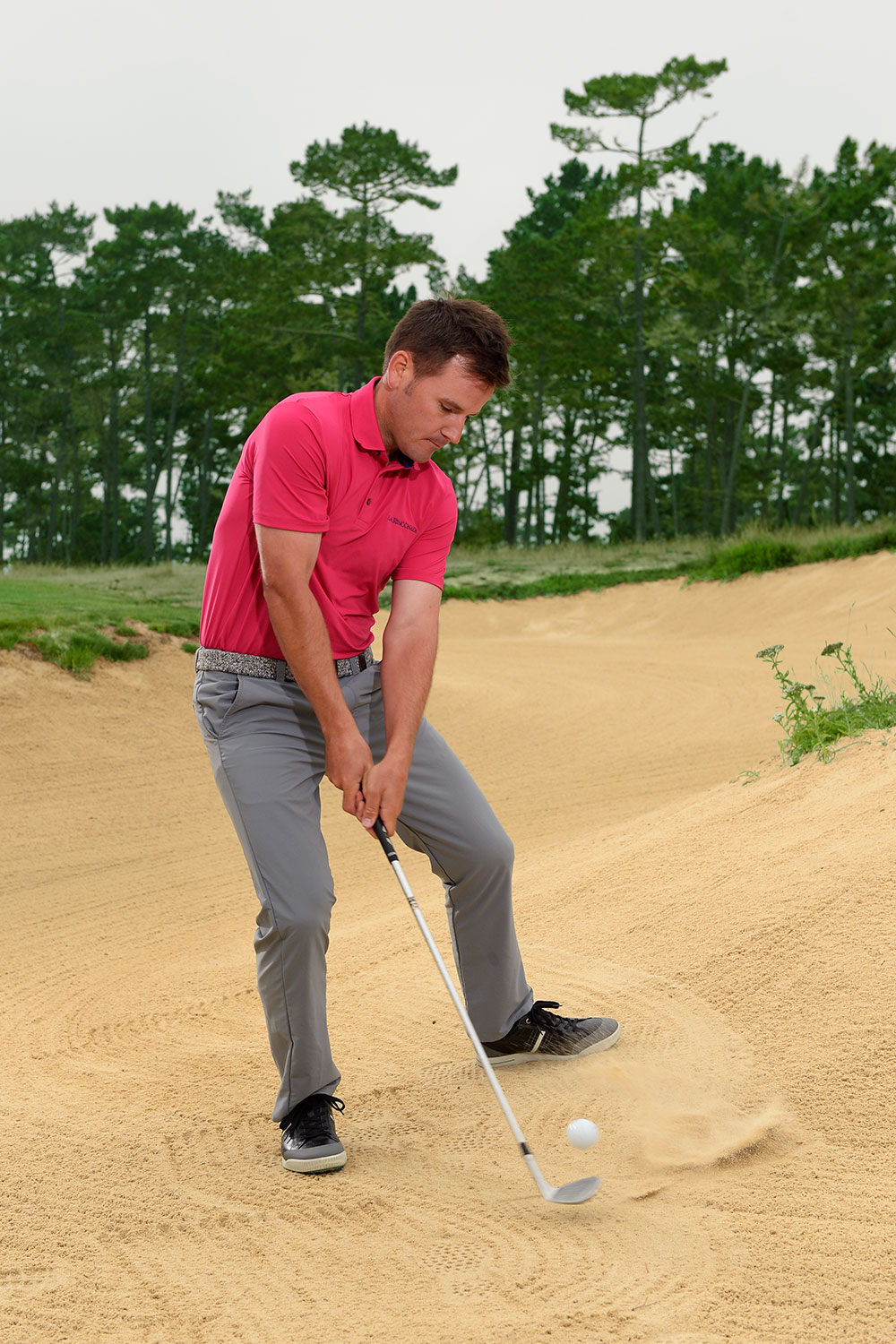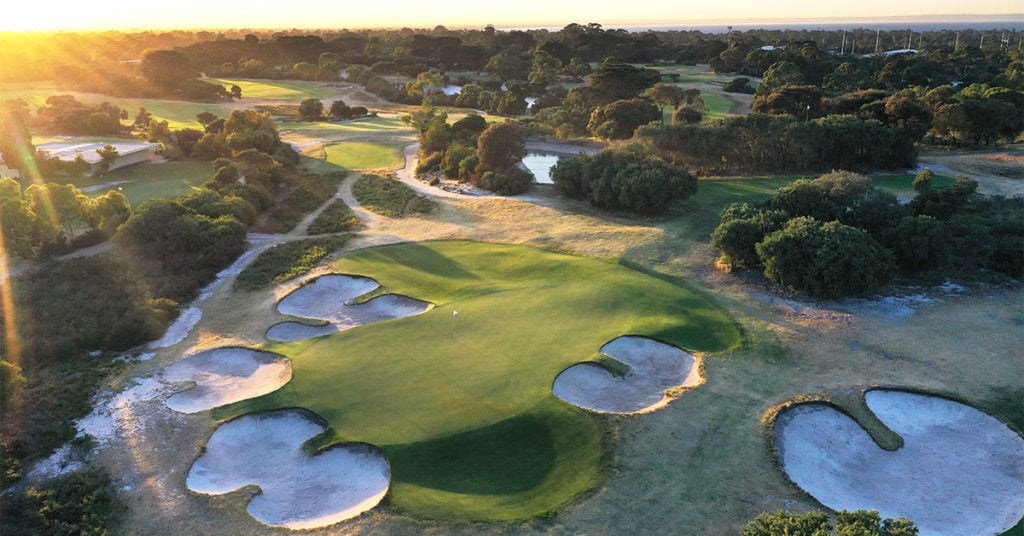Whether you find your ball in a difficult lie or you’re playing a hole with a design feature that makes you anxious, these are the moments in any given round that often determine if you stroll or trudge back to the car park. To avoid taking big numbers, go with the play that has a higher chance of success – like finding the quickest route back into the fairway from the trees [above]. To punch out, play the ball back in your stance and make an easy swing with your 7-iron, focusing on solid contact. Here are four other typically nerve-wracking situations and how to deal with them.
Narrow Fairways
Thread the Hula Hoop
You’ve got trees pinching in on both sides of the tee, and the landing area looks narrower than a terrace house’s backyard.

How in the world are you going to put this one in play? Start with a reality check. Don’t try to hit your first dead-straight drive since the New Kids On The Block were actually kids. Commit to your natural shot shape and aim accordingly. That means seeing where the ball should finish and where it needs to start. Now here comes the Jedi Mind Trick: once you’ve set up to play your shot shape and are ready to swing, take one last look down the fairway and visualise you’re about to park one on a driving range [left]. Erase the trouble from your internal vision. That will help you alleviate tension and make a confident swing.
Nasty Bunker Lies
Forget the flag and aim for the fat part of the green
 When you find your ball in a bad lie in a greenside bunker – especially this downhill beauty I’m dealing with [left] – ratchet down your goal. My advice is to aim for the fattest part of the green, even if it’s away from the flag. Don’t try to be a hero. This downhill lie means the ball will come out lower and with less backspin unless you adjust your stance and swing to compensate. Get into as stable a stance as you can with your shoulders aligned down the slope. Open the face of your wedge and then swing down the slope with as much energy as you can muster without losing your balance. You need the open face to get the ball up and the speed to impart more spin to stop the ball.
When you find your ball in a bad lie in a greenside bunker – especially this downhill beauty I’m dealing with [left] – ratchet down your goal. My advice is to aim for the fattest part of the green, even if it’s away from the flag. Don’t try to be a hero. This downhill lie means the ball will come out lower and with less backspin unless you adjust your stance and swing to compensate. Get into as stable a stance as you can with your shoulders aligned down the slope. Open the face of your wedge and then swing down the slope with as much energy as you can muster without losing your balance. You need the open face to get the ball up and the speed to impart more spin to stop the ball.
Forced Carries
Be realistic about how far you hit it
 You’re capable of hitting that 5-iron 190 yards; I believe you. But honestly? If I gave you 10 tries, how many would end up 10 to 20 yards shorter? That’s what I thought. When you’ve got to carry a hazard or some other obstacle to reach the green, it’s smart to pad the distance you need to hit your next shot. Maybe go with the distance to the back of the green instead of the middle. If you don’t hit it perfect, you’ll still likely land the ball somewhere safe. Another way to make sure you get it there is by hitting the ball solidly. Do that by making a smooth – not slow – swing while keeping the clubhead travelling low through impact. A good swing thought is to pretend you’re hitting another ball in front of the one you’re addressing [above]. This will help override the impulse to rise out of your posture during the downswing in the hopes of hoisting the ball onto the green. If you stay down through impact, you’ll compress it.
You’re capable of hitting that 5-iron 190 yards; I believe you. But honestly? If I gave you 10 tries, how many would end up 10 to 20 yards shorter? That’s what I thought. When you’ve got to carry a hazard or some other obstacle to reach the green, it’s smart to pad the distance you need to hit your next shot. Maybe go with the distance to the back of the green instead of the middle. If you don’t hit it perfect, you’ll still likely land the ball somewhere safe. Another way to make sure you get it there is by hitting the ball solidly. Do that by making a smooth – not slow – swing while keeping the clubhead travelling low through impact. A good swing thought is to pretend you’re hitting another ball in front of the one you’re addressing [above]. This will help override the impulse to rise out of your posture during the downswing in the hopes of hoisting the ball onto the green. If you stay down through impact, you’ll compress it.
Tight Lies Around The Green
Take a little off the top
 Too often I see amateurs try to chip off a tight lie using their most lofted club with the handle leaning too far forward. Bad choice. The club doesn’t interact with hard turf very well if you go that route. You’ll likely chunk or thin the shot. Instead, take your sand wedge, lean the handle slightly forward at address,
Too often I see amateurs try to chip off a tight lie using their most lofted club with the handle leaning too far forward. Bad choice. The club doesn’t interact with hard turf very well if you go that route. You’ll likely chunk or thin the shot. Instead, take your sand wedge, lean the handle slightly forward at address,
and play a medium-trajectory shot. It helps if you keep your lead arm (left for righties) soft and your shoulders level with the ground [left]. Narrowing your stance will also help you from overswinging. Speaking of the swing, a great thought to get the club to slide under the ball and pop it up is to focus on
giving the grass a little flattop buzz cut through impact.
– with Ron Kaspriske
Matt Wilson, a Golf Digest Best Young Teacher, is based at Golf Canada in Oakville, Ontario




